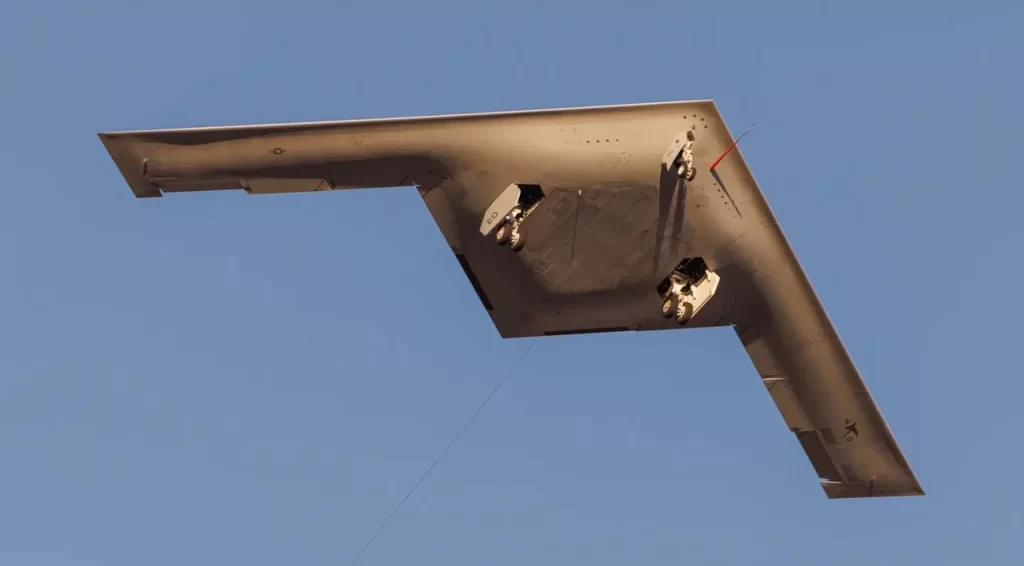It has been reported that the first flight of the prototype T-1 of the new American stealthy strategic bomber B-21 Raider took place on November 10, 2023, at the airfield of the Plant 42 facility of the American firm Northrop Grumman in Palmdale, California. The first flight occurred at the United States Air Force Base Edwards in California, where the aircraft was tested at the United States Air Force Test Centre.
The first flight of the B-21 has not been officially reported; nevertheless, Northrop Grumman published some material on November 10, 2023, in which they stated that the B-21 reflects the development of the US Air Force strategic bomber fleet and is the world’s first aircraft of the sixth generation to take to the skies. When it comes to the United States of America’s determination, the Raider will provide the United States Air Force with a higher survivability rating, a better flight range, and payload flexibility. The B-21 can get through the toughest defences and deliver pinpoint strikes almost anywhere.
After some time, a United States Air Force spokesperson named Ann Stefanek revealed to The War Zone that the B-21 Raider is currently undergoing flight testing. She said that flight testing is an essential component of the testing campaign by the United States Air Force Test Centre and the B-21 Combined Test Force of the 412th Test Wing.
Recap: the Next-Generation Bomber (NGB) programme, which began developing a low-observable American strategic bomber in the 2000s, was halted for a spell before being relaunched in 2010 as the Long Range Strike Bomber (LRS-B). Northrop Grumman was given the official task of responding to a call for proposals from the United States Air Force in July 2014. There were two competing aircraft programmes from the commencement of the NGB work and later with the LRS-B work. One of these projects was led by Northrop Grumman, and a Boeing and Lockheed Martin consortium led the other. Both concepts represented subsonic aircraft with a flying-wing design and were conceptually comparable to the Northrop Grumman B-2A Spirit stealth bomber.

The United States Department of Defence announced on October 27, 2015, that it had picked Northrop Grumman’s idea for the LRS-B programme and had given an initial contract to develop the aircraft with a value of $21.4 billion. The whole cost of the programme, including research and development as well as deliveries, is anticipated to be between $80 and $90 billion. The futuristic aircraft was given the designation B-21 and the moniker Raider in 2016, and it is currently being referred to as a “sixth-generation bomber.”
The Northrop Grumman Plant 42 in Palmdale is now responsible for producing six B-21 prototypes, five planned for flight tests and one destined for ground tests. Since 2019, the lead flight prototype T-1 has been undergoing construction. It was finally finished in March of 2022 when factory ground tests were initiated in a designated location. Additionally, it was believed that the prototype for ground tests, known as G-1, was finished in 2022. On December 2, 2022, an official public presentation ceremony of the first flying prototype of the B-21 Raider took place at Palmdale. In September, the T-1 prototype underwent its first engine run and a series of taxi tests; now, it is in the air for the first time.
It is anticipated that the initial production units of the B-21 will be delivered between 2026 and 2027. Initial Operational Capability (IOC) is expected to be attained by 2030. Between one hundred and two hundred B-21 aircraft are anticipated to be acquired by the US Air Force to replace the B-1B and B-2A strategic bombers. Annual allocations of six to seven B-21 aircraft are anticipated to be procured beginning with the 2025 fiscal year, with the potential to increase to fifteen aircraft annually during the 2030s. As a result, the US Air Force endeavours to maintain a diverse fleet of strategic bombers, comprising the recently upgraded Boeing B-52 Stratofortress bombers and the brand-new B-21 Raider.
Since the inception of the LRS-B programme, the procurement cost objective for a single production aircraft has been set at $550 million. Unofficially, however, the estimated procurement cost per aircraft ranges between $700 and $750 million. This figure is not formally disclosed.
The B-21 is built on the low-observable subsonic flying-wing bomber’s structural design principles. It looks a lot like the Northrop Grumman B-2A; however, it has somewhat smaller dimensions. Its wingspan is 45 metres, unlike the 52 metres of the B-2A. In addition, the new aircraft features a deeper recessed engine air intake and a larger wing aspect ratio. Next-generation radio-absorbing coatings are used. The F-35 fighter aircraft’s F135 engine is the source of two recently developed Pratt & Whitney engines fitted in the B-21. According to information known to the public, the maximum cargo capacity is expected to be 13,600 kg; conversely, its weapon bays will be larger than those of the B-2A. The “open architecture” and system adaptability of the B-21 allows for the potential creation of an unmanned counterpart in the future.
